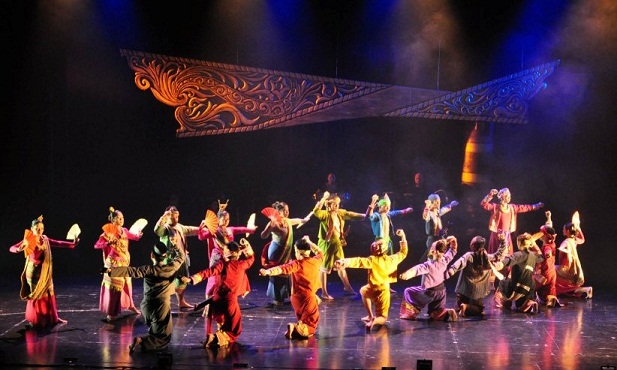By ELIZABETH LOLARGA
Photos courtesy of Tanghalang Ateneo
“STROMBOTIC spectacle,” to borrow gay lingo, is the only phrase that can describe Tanghalang Ateneo’s production of Sintang Dalisay which had a short, move-over engagement at the Asian Center Auditorim at the University of the Philippines Diliman after it was staged anew at the recent National Theater Festival. It received accolades and a prolonged standing ovation at the Belarus International Theater Festival in Eastern Europe in July this year.
Based on Shakespeare’s Romeo and Juliet and National Artist for Literature Rolando Tinio’s translation of the play into Filipino, with additional materials from ancient awit (song) based on the star-crossed lovers’ love story when it first reached the Philippines, Sintang Dalisay is a breath of fresh air.
It comes right after the commemoration of the unsolved Ampatuan massacre in Muslim Maguidanao and the announcement of peace in Bangsamoro-land. That massacre in November 2009 involved two warring political clans not unlike the fictive houses of Montague and the Capulet in Shakepeare’s era.
Director Ricardo Abad, actor, sociology professor at the Ateneo de Manila University and acting head of its fine arts program, set this version of a tale as old as time in Muslim Mindanao. He went to the extent of bringing over and consulting nine teachers from Tawi-tawi to correctly get the Sama language (or Badjao) inflections along with Arabic humming and droning that were used in the last scene.
Another National Artist, production designer Salvador Bernal, was in the picture before he died. He executed Abad’s vision of the look of the musical play. Abad said, “I told him that I didn’t want it to look like an auditorium. Don’t give me a hall, give me a village where the musicians and chorus can be onstage.”
What Bernal did was to design a gigantic golden panolong (a hand-carved beam with okir design sticking out of the front of a house) hovering horizontally over the stage with a massive post of a torogan standing vertically underneath. These architectural features suggest that young lovers come from rival wealthy families whose enmity is aggravated by blood debts when Taupan (Tybault in the original Shakespeare) is killed.
All characters carry Islamic names: Rashiddin for Romeo, Jamila for Juliet, Imam for Friar Lawrence, etc. The imam serves a triple role in repertory fashion of being chief chanter/narrator, the holy man who solemnizes the secret wedding of the lovers and lastly, the apothecarist or mambabarang who gives the sleeping potion to Jamila to make her appear dead.
Adding to the spectacle are indigenous ritual, social and theatrical dances reminiscent of Ligaya Amilbangsa’s work in reviving the pangalay, now appropriated by her former student, the play’s movement and dance choreographer, Matthew Santamaria, as igal. UP art studies Prof. Edru Abraham designed the music, assembling his Kontra-gapi from UP with Tanghalang Ateneo’s (TA) Music Ensemble.
When the International University Theater Association held a small conference at Miriam College in Quezon City in 2011, TA presented Sintang Dalisay to the delegates. That early it already created a buzz. When the group was chosen to represent the country in Belarus, Ateneo and other sponsors could only afford to send 10 people (five actors, two musicians, one technical person and Abad who also pitched in as musician.
Abad recalled that they had half day to rehearse and to set up. The theater was full because the delegates who were in Manila last year had spread word how good the Filipino production was. As the play unfolded, Abad observed the quiet audience, worried that people weren’t reacting.
After the cast took its bow, he was amazed as row after row of audience members stood up and applauded for several minutes. He said, “The reception was wild! There was a people’s choice vote. At the final count, Lithuania earned 8.8 points while the Philippines tied with France at 8.7. An old French teacher of drama came to us backstage to hug the cast and me. She said she was so touched.”
Back in the home country, however, a Muslim delegate to the National Theater Festival reacted violently to Sintang Dalisay, complaining to Cultural Center of the Philippines officers and even threatened to kill the cast and director. Abad explained to the CCP officers that TA took care to follow their Muslim consultants’ recommendations so that the scenes like the wedding of Jamila and Rashiddin would look authentic. Their lovely love-making dance was performed on a banig (mat).
Abad dismissed the complaint as coming from a fundamentalist who was taking the play literally and not allowing the theater artists some artistic license.
The warm reception from students and faculty at the Asian Center indicates a hunger for good original Filipino theater. The play’s recent Aliw awards for best director and best production design are richly deserved.
Sintang Dalisay is available for bookings. Email rickyabad@yahoo.com.

